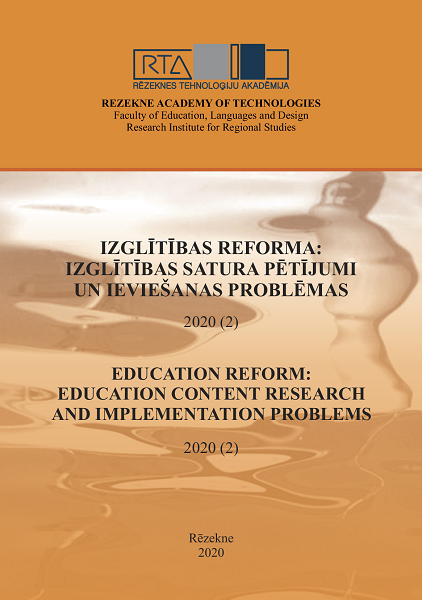USE OF INFORMATION TECHNOLOGY IN THE SOUND “S” CORRECTION PROCESS FOR 5–6–YEAR–OLD CHILDREN WITH PHONETIC DISORDERS
DOI:
https://doi.org/10.17770/er2020.2.5346Keywords:
correction of sound pronunciation, information technology, pre–school age childrenAbstract
Today, the pre–school education system is undergoing major changes aimed at improving the quality of education. New approaches, methods, and programmes are being developed. There is an increased need to introduce innovative technologies that are designed to gain new knowledge, accelerate the process of obtaining knowledge, improve the quality of education, and increase the motivation of children. The development of speech, which includes the ability to clearly pronounce sounds and distinguish them, to control the articulation apparatus, to correctly form a sentence, is one of the most urgent tasks that speech therapists at pre–school institutions should solve.
Downloads
References
Daniela, L., Rubene, Z., & Goba, L. (2018). Datu apkopojums un ārvalstu un Latvijas pieredzes analīze par digitālo mācību līdzekļu pieejamību un izmantošanu vispārējās izglītības mācību satura nodrošināšanai. Pasūtītājs: Izglītības un zinātnes ministrija. Retrieved from https://www.izm.gov.lv/images/statistika/petijumi/Datu–apkopojums–un–rvalstu–un–Latvijas–pieredzes–analze–par–DML_2018.pdf
Dmitriev, J. A., Kalinina, E.V., & Krotova, T.V. (2016). Informacionnye i kommunikacionnye tehnologii v professional'noj dejatel'nosti pedagoga doshkol'nogo obrazovanija. Moskva: Moskovskij pedagogicheskij gosudarstvennyj universitet.
Draviņa, V. (1992.) No pieciem mēnešiem līdz pieciem gadiem. Rīga: Zvaigzne.
Fomicheva, M. F. (1989). Vospitanie u detej pravil'nogo proiznoshenija. Moskva: «Prosveshhenie».
Hayes, М.& Whitebread, D. (2006). ICT in the Early Years. England: Open University Press.
Ieteicamās mācību metodes, paņēmieni un organizācijas formas. (2013). Latvijas pašvaldību mācību centrs. Eiropas Komisijas Informācijas sabiedrības un plašsaziņas līdzekļu Ģenerāldirektorāta programmas „Drošāks internets” projekta „Droša interneta lietošana” ietvaros. Retrieved from https://lpmc.lv/uploads/media/Macibu_metodes.pdf
Jel'konin, D. B. (1998). Razvitie rechi v doshkol'nom vozraste. Moskva: Prosveshhenie.
Kalash, I. (2011). Vozmozhnosti informacionnyh i kommunikacionnyh tehnologij v doshkol'nom obrazovanii. Moskva: Institut JuNESKO po informacionnym tehnologijam v obrazovanii.
Kalinina, T. V. (2008). Novye informacionnye tehnologii v doshkol'nom detstve. Moskva: Sfera.Upravlenie DOU.
Kas'janova, A. V., Vasil'eva, N. N., & Golovina, E. B. (2013). Pedagogika: tradicii i innovacii: materialy III mezhdunarodnoj zaochnoj nauchnoj konferencii. Povyshenie motivacii k logopedicheskim zanjatijam u starshih doshkol'nikov s ispol'zovaniem IKT. (50–52.) Cheljabinsk: Dva komsomol'ca. Retrieved from https://moluch.ru/conf/ ped/archive/69/3654/
Logopēdiskā palīdzība vispārizglītojošās izglītības iestādēs Latvijā. (2015). Latvijas Logopēdu asociācijas darba grupa. Retrieved from http://logopedi.lv/faili/faili/2015/ rekomendacijas%20logopediska%20darba%20organizacijai%20visparizglitojosas%20izglitibas%20iestades.pdf
Miltiņa, I. (2005). Skaņu izrunas traucējumi. „Izdevniecība RaKa”.
Osin, A.V. (2007). Jelektronnye obrazovatel'nye resursy novogo pokolenija v voprosah i otvetah. Pieejams http://window.edu.ru/catalog/pdf2txt/957/63957/34442?p_page=1
Revnivceva, R.M. (2012). Pedagogika: tradicii i innovacii (II). Materialy mezhdunarodnoj zaochnoj nauchnoj konferencii. Informacionno–kommunikacionnye tehnologii v doshkol'nom obrazovatel'nom uchrezhdenii, 67–69. Retrieved from https://moluch.ru/ conf/ped/archive/63/
Stavceva, J. G. (2015). Informacionno–kommunikacionnye tehnologii v doshkol'nom obrazovatel'nom uchrezhdenii. Zhurnal Gaudeamus, 1.
Stavceva, J. G. (2015). Informacionno–kommunikacionnye tehnologii v doshkol'nom obrazovatel'nom uchrezhdenii. Zhurnal Gaudeamus, 1.
Siraj–Blatchford, I. & Siraj–Blatchford, J. (2006). A Guide to Developing the ICT Curriculum for Early Childhood Education. London: Trebtham Books Limited. Retrieved from www.academia.edu/
Skaista, U. & Bārda, E. (2011). Valodas (runas un rakstu) attīstības veicināšana bērniem no 5 līdz 8 gadiem. Valsts izglîtîbas satura centrs, SIA “Apgāds Mansards”. Retrieved from https://visc.gov.lv/vispizglitiba/saturs/dokumenti/metmat/valattveic_5_8.pdf
Tomele, G. (2015). Runas un valodas attīstības multistruktuālais modelis veseluma pieejas aspektā. Rēzeknes Augstskola. Retrieved from http://journals.ru.lv/index.php/ SIE/article/viewFile/392/501
Tūbele, S. (2019). Valodas traucējumu novērtēšana. Rīga: RaKa.


